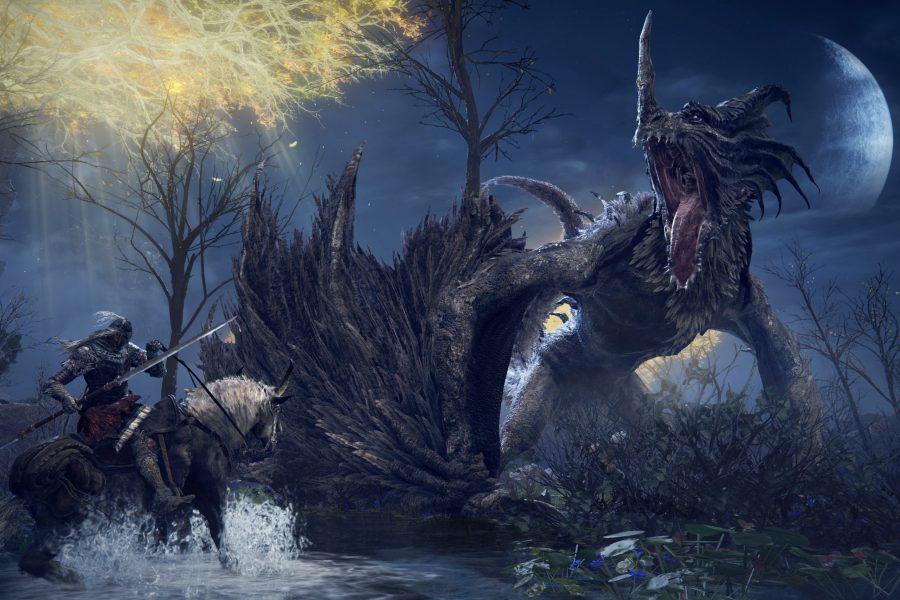Elden Ring proves that the hardest destinations to reach always have the prettiest views.
I prodded through the mist on foot, a magic katana in one hand and a silver shield in the other. The craggy path through the Forbidden Lands was shrouded by dead trees, snowdrifts, and an ominous fog; its navigation made even more difficult by the dangerous and acrobatic enemies. At the end of the path, I was greeted by the welcoming sight of a massive demonic gargoyle wielding a colossal double-bladed sword. The ominous red health bar at the bottom of my screen introduced him as Black Blade Kindred, accompanied by a booming orchestral score. With an arsenal of spells and magic weapons, I had never felt more prepared for a boss battle. This was, of course, until I noticed that he also had an axe producing 10-foot shockwaves. Needless to say, I died within seconds, then I died 11 more times before finally quenching my thirst for victory. After 95 hours and 111 levels, “Elden Ring”was still challenging me like no game had before, one of the many qualities that make it such an incredible game.
“Elden Ring,” the latest title from Japanese developer FromSoftware, is an open-world, action role-playing game set in the dark fantasy world of the Lands Between. Players control a customizable character who is tasked with reforging the titular Elden Ring, a magic artifact shattered into six pieces that each grant immense powers. The six demigods who rule the Lands Between each use a piece of the Ring to cement their powers. In order to reforge the Ring, the player must defeat the demigods one-by-one.
It’s a somewhat simplistic premise, but the story is made much more complex by the extensive lore and backstory behind the world. Much like previous FromSoftware games such as “Dark Souls,” the story is somewhat vague and ambiguous in the beginning. Your character is launched into the world with little explanation as to their origins and little direction other than a golden arrow on the map. The next story cutscene, which begins to introduce the premise and the player’s mission, requires the player to explore the forest surrounding the starting area. Additionally, the vagueness and depth of the world and story requires close attention to side quests and item descriptions. It’s a unique approach to storytelling, akin to putting together pieces of a puzzle, which I found made the world and story feel cohesive. However, this is made slightly frustrating at times due to the lack of a quest journal, which makes it hard to keep track of key characters and events. Regardless, the plot and lore are compelling, and it inspires the player to explore the world for answers, an essential part of the experience.
The Lands Between is immense and rich with detail; never boring or repetitive. The world is split into five regions, each with their own unique character and atmosphere. These ranged from the mysterious, fog-shrouded lake of Liurnia to the hellish, festering red swamps of Caelid; its landscape marred by the blight known as Scarlet Rot. On an Xbox Series S, the graphics were not quite cutting-edge but certainly vivid and detailed enough to capture the incredible vistas and stunning landscapes. The hardware limitations of the console meant I could not appreciate “Elden Ring”’s full graphical potential. However, the games’ graphics shine regardless in part due to fantastic art style and direction.
Each region was littered with endless ruins, castles, and dungeons with unique enemies and loot. I was impressed with how my curiosity was often rewarded. In one instance early in my playthrough, I stumbled upon a small, mysterious dome structure in a forest. Inside, I found a lift leading to an underground crevasse with some crumbling stone ruins. As I slowly ventured inside, I stumbled upon a massive cavern containing a ruined underground city. Great stone pillars loomed beneath gemstones in the ceiling that twinkled like stars. These discoveries left me enthralled by the game’s sheer scope, and left me wanting to explore more.
The world is as friendly as it is empty, or in other terms, almost everything wants to kill you. The Lands Between is teeming with dangerous and powerful enemies in every corner. I have fought — or run away from — everything from lightning-casting knights to razor-taloned falcons to giant lobsters and grotesque dinosaur-dog hybrids. Make no mistake: “Elden Ring” is unforgiving, and punishes you for mistakes. You will die. A lot. But you will learn to embrace each death as another step towards finally conquering your enemy.
On their journey, players will find it necessary to master the fluid combat system, an intricate “dance of death.” Players can dodge and roll away from enemies’ attacks, but must be careful not to accidentally roll into a projectile or delayed attack. Parrying, blocking, and counter-attacking is a must. Alongside physical combat, the use of magic is essential; summons can be used to distract or overwhelm powerful bosses. Various sorceries can be acquired to deal damage from a distance, and weapon enchantments give melee weapons new abilities. Consumable items can buff your character, or apply status effects to enemies. Each bossfight or dungeon requires a unique approach as you learn which attacks and strategies work and which ones don’t.
For example, dual-wielding can hack apart larger, clunkier enemies such as golems and trolls, provided you can dodge their attacks. Against more mobile enemies, such as knights and foot soldiers, this will become a lot less effective than blocking with a shield and patiently waiting to counter. Character construction is very important as well; each attribute scales with different weapons and players must hone their attributes to fit their playstyle, with limited attribute points available. A strength-based character can take more damage, wear heavy armor, and swing massive greatswords, but will have less capabilities to deal damage from afar compared to an Intelligence-based character, which can use sorceries. Intelligence-based characters have access to a wide range of magic, but not the incantations requiring the Faith attribute. This character system not only allows for balance but allows for replayability: different character builds will have different experiences.
When most enemies pose a formidable challenge, each encounter becomes a high-stakes, thrilling affair. The difficulty balances perfectly with the combat, as you are given plenty of tools and options to poke at your enemies’ weaknesses. The result is a gameplay loop that is equal parts intoxicating, maddening, and rewarding. After finally slaying a powerful boss, the joy of revenge is like no other. “Elden Ring” is one of the few games that makes you truly feel like a conqueror, and makes your accomplishments feel all the more meaningful and fulfilling.
Looking back, I entered the world of “Elden Ring” on a whim, buying it after a recommendation from a friend. Not knowing what to expect, I found myself blown away. “Elden Ring” combines intense, exciting gameplay with an incredible and beautiful open-world of gigantic proportions. The difficulty is certainly not for everyone, but I’ve found few games to be as rewarding or addicting. If you’re up for the challenge, the journey is more than worth it.
Grade: A+
Developed by: FromSoftware
Released: February 25, 2022
Rated: M
Image courtesy of NPR.
Categories:
Video Game Review: “Elden Ring”
Mar 27, 2022
4
0
More to Discover









Tom Jones • Apr 16, 2022 at 1:25 pm
Great game!!
John McQuain • Mar 28, 2022 at 10:02 pm
This journey took me 325 hours to totally complete. I finished and rolled credits at about 250 hours. Then one secret area led to another secret area. I was in an Avitar type tree and it was tense all the way to the bottom and grand finale boss. Epic gameplay. Brutal and not for the faint of heart.